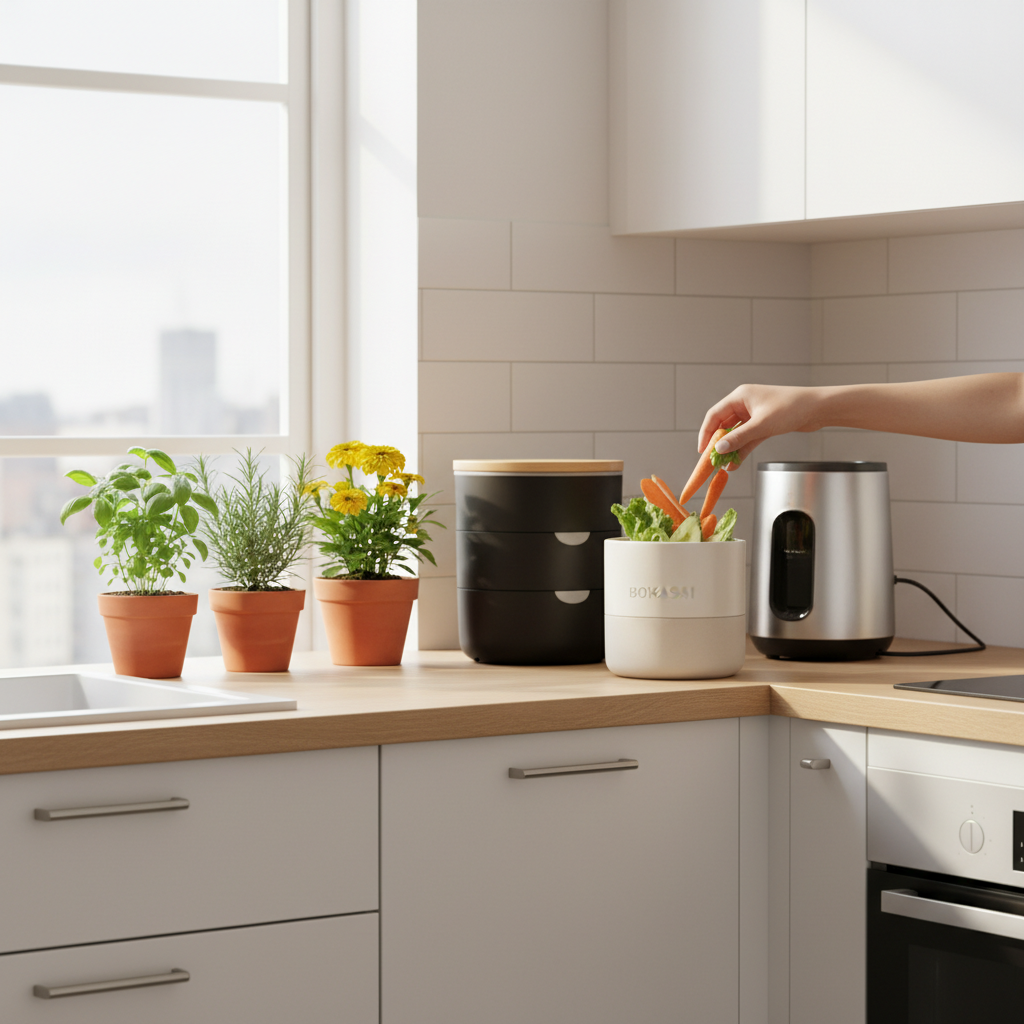Living in a bustling city apartment often means sacrificing a lot of things – a spacious garden, a sprawling backyard, and sometimes, even the dream of living a truly sustainable, zero-waste life. I used to think composting was one of those things. Every time I tossed food scraps into the garbage, a little piece of me cringed, knowing it was headed straight for a landfill, contributing to methane emissions and a mountain of waste.
For years, I told myself it was impossible. “It’ll smell,” I thought. “Where would I put it? I barely have room for my coffee maker!” And, “Don’t you need a whole garden to even use the compost?” But then, I started seeing articles, snippets on social media, and even a friend boasting about their tiny worm farm. Curiosity (and a growing sense of guilt) finally got the better of me. I decided to dive in, headfirst, into the world of apartment composting. And let me tell you, it’s been one of the most rewarding eco-conscious decisions I’ve ever made.
If you’re an urban dweller like me, longing to reduce your environmental footprint but feeling constrained by your living situation, this article is for you. I’m going to share my journey, my trials and triumphs, and everything I’ve learned about setting up a successful, smell-free, and surprisingly simple composting system right in your apartment. Forget the myths; it’s easier than you think, and you absolutely don’t need a sprawling backyard to make a difference.
Why Even Bother Composting in a Small Apartment?
Let’s be honest, composting might seem like just another chore, especially when you’re already juggling work, city life, and trying to keep your tiny space tidy. But the impact of composting, even on a small scale, is huge. Here’s why I decided it was worth it:
- Significant Waste Reduction: Food waste accounts for a massive portion of landfill content. When food scraps decompose in landfills, they produce methane, a potent greenhouse gas. By composting, you divert these organics, reducing harmful emissions. My own kitchen waste has plummeted by at least 50% since I started!
- Rich Soil for Your Plants: Even if you don’t have an outdoor garden, you likely have a few houseplants. Finished compost, often called “black gold,” is an incredible natural fertilizer. My indoor plants have never looked healthier, and I love knowing I’m feeding them with something I created myself.
- A Sense of Empowerment: There’s a deep satisfaction that comes from knowing you’re actively doing something good for the planet. It’s a small step, but it’s a tangible one, and it feels great to be part of the solution.
- It’s Simpler Than You Think: Seriously, the biggest hurdle is usually just getting started and overcoming those initial fears of smell or mess. Once you pick a system, you’ll wonder why you didn’t start sooner.
Choosing Your Apartment Composting System: My Top Picks
This is where the rubber meets the road! There isn’t a one-size-fits-all solution for apartment composting. What works best for you depends on your comfort level, the types of scraps you produce, and how much space (and patience!) you have. Here are the three main types I’ve explored and would recommend for apartment dwellers:
Bokashi Composting: The Fermentation Powerhouse
My first foray into apartment composting was with Bokashi. I was intrigued because it promised to handle *almost all* food waste, including meat, dairy, and cooked food – things traditional outdoor compost piles can’t usually take. And the best part? No smell!
How it works: Bokashi isn’t true composting; it’s a fermentation process. You layer your food scraps in an airtight bin with Bokashi bran (which contains beneficial microbes). These microbes ferment the food, pickling it essentially. After a couple of weeks, you’ll have “fermented” scraps and “Bokashi tea” (a nutrient-rich liquid). The fermented scraps theeed a secondary burial stage to break down into soil (more on that later).
- Pros:
- Handles almost ALL food waste, including meat, bones, dairy, and oils.
- Totally odorless during the fermentation process (seriously, no smell!).
- Compact and can be kept under a sink or in a small corner.
- Produces “Bokashi tea” that can be used as a liquid fertilizer.
- Cons:
- Doesn’t produce finished compost directly in the bin; it’s a two-stage process.
- Requires purchasing Bokashi bran.
- The fermented scraps are acidic and need to be buried or added to a worm bin for final decomposition.
My Experience: I started with a simple two-bucket system. It was incredibly easy to use daily. The lack of smell was a game-changer. The challenge was finding a place for the “second stage” burial. I ended up creating a small soil factory in another container on my balcony, or sometimes I’d drop off my fermented scraps at a community garden. If you have a balcony or even just a large plant pot, this system is fantastic.
Vermicomposting: Your Tiny Wormy Roommates
After getting comfortable with Bokashi, I ventured into vermicomposting (worm composting). This felt a little more “natural” and produced beautiful, rich compost directly. Plus, the worms are surprisingly fascinating to watch!
How it works: You create a cozy home for special composting worms (usually Red Wigglers) in a multi-tiered bin. You feed them your fruit and vegetable scraps, and they, along with other microorganisms, break down the food into nutrient-dense “worm castings” (aka worm poop – but it’s gold for plants!) and “worm tea” (leachate).
- Pros:
- Produces incredibly rich, high-quality compost (vermicompost) and liquid fertilizer (“worm tea”).
- Relatively odorless if managed correctly.
- Engaging and educational – great for kids too!
- Doesn’t require electricity.
- Cons:
- Caot handle meat, dairy, oily foods, citrus in large quantities, or spicy foods.
- Requires specific conditions (temperature, moisture) to keep worms happy.
- Can feel a bit “icky” for some people at first.
- Takes longer to process large quantities of waste compared to Bokashi.
My Experience: I started with a small, stackable worm bin. The initial setup involved buying worms (yes, you can order them online!) and preparing their bedding. The key is balance: not overfeeding, keeping the bedding moist like a wrung-out sponge, and maintaining a consistent temperature. Once I got the hang of it, it became a smooth operation. My worm bin sits discreetly in a corner of my living room, and I’ve never had an issue with smell or pests. The worm castings are pure magic for my houseplants!
Electric Composter / Food Recycler: The High-Tech Solution
This is the newest addition to the apartment composting scene and a great option for those who want ultra-convenience and don’t mind an appliance. I consider this more of a food recycler than a traditional composter, but it significantly reduces food waste volume.
How it works: These devices typically grind, heat, and dry your food scraps, transforming them into a sterile, odorless, and much-reduced volume material in just a few hours. Think of it like a super-efficient food dehydrator and grinder all in one.
- Pros:
- Extremely fast process (often 4-8 hours).
- Significantly reduces the volume of food waste (up to 90%).
- Handles almost all food scraps, including small bones and shells.
- Completely odorless during and after the process.
- Very clean and hands-off.
- Cons:
- Requires electricity to operate.
- Doesn’t produce “true” living compost, but rather a nutrient-rich soil amendment.
- Higher upfront cost compared to Bokashi or worm bins.
- The output isn’t ready for immediate use as compost; it ofteeeds further decomposition or mixing with soil.
My Experience: I borrowed one of these from a friend for a few weeks, and the convenience was undeniable, especially when I had unexpected dier guests and a lot of diverse scraps. It made quick work of everything from leftover chicken bones to citrus peels. The resulting material looks a bit like coffee grounds and is excellent for mixing into potted plant soil or adding to a garden bed as a slow-release fertilizer. It’s perfect if you’re time-poor and prioritize speed and cleanliness, but understand it’s a different kind of “composting.”
Setting Up Your Chosen System: A Step-by-Step Guide
Regardless of which system you choose, a few general principles will make your apartment composting journey smooth and successful.
Location, Location, Location
This is key in a small apartment! For Bokashi and electric composters, a discrete spot under the sink, in a pantry, or even a corner of your kitchen or balcony works well. They are generally odor-free. For vermicomposting, choose a spot with stable temperatures (not too hot, not too cold) and out of direct sunlight. A quiet corner, a closet, or a balcony (if temperatures are mild year-round) can work. I keep my worm bin in a low-traffic corner of my living room, and it’s practically invisible.
Gathering Your Tools
- For Bokashi: A Bokashi bucket (often comes with a spigot), Bokashi bran, a small trowel or spoon to mix/compress scraps, and a collection container for the “tea.”
- For Vermicomposting: A multi-tiered worm bin, red wiggler worms, bedding material (shredded newspaper/cardboard, coco coir), a spray bottle for moisture, and a hand rake/trowel.
- For Electric Composter: Just the unit itself, really!
The Golden Rules of Apartment Composting
While each system has its specific needs, some universal truths apply:
- Know Your Scraps: Be mindful of what goes into your chosen system. While Bokashi is quite forgiving, worms are picky. Avoid overloading any system.
- Moisture is Key: For worm bins, keep the bedding moist but not soaking wet (think a wrung-out sponge). For Bokashi, ensure your scraps aren’t excessively watery.
- Airtight Matters (for Bokashi): Bokashi needs an anaerobic (oxygen-free) environment. Make sure your lid is sealed tight after each addition.
- Don’t Be Afraid to Experiment: You’ll learn what works best for your specific setup and habits. Don’t get discouraged by initial hiccups.
Troubleshooting Common Apartment Composting Hurdles
Let’s tackle those nagging worries head-on. Trust me, I’ve faced them all!
“It Smells!”
This is the #1 fear, and usually, it’s easily fixable.
- Bokashi: If your Bokashi smells rotten instead of a pleasantly sour, yeasty smell, it might not be airtight, or you might not be using enough bran.
- Worm Bin: A rotten smell usually means too much food, too much moisture, or the wrong kind of food (meat/dairy). Reduce feeding, aerate, and add more dry bedding.
- Electric Composter: These are designed to be odorless. If it smells, there might be a rare malfunction or something truly putrid was added.
Generally, if you follow the guidelines, smells shouldn’t be an issue.
“Pests Are Showing Up!”
This is rare in well-maintained apartment systems.
- Worm Bin: Small fruit flies can appear if food is left exposed. Bury food scraps deeply in the bedding. Avoid leaving the lid open. Fungus gnats usually indicate too much moisture.
- Bokashi: Because it’s airtight, pests are almost never an issue during fermentation.
- Electric Composter: The process is too fast and hot for pests.
“What Do I Do with the Finished Compost?”
Ah, the black gold!
- For Indoor Plants: Mix a small amount into your potting soil when repotting, or sprinkle it on top as a slow-release fertilizer. Your plants will thank you!
- Community Gardens: Many urban areas have community gardens that welcome compost donations. This is a fantastic way to give back.
- Friends & Family: Do you know anyone with a garden? They’ll likely be thrilled to take your nutrient-rich compost off your hands.
- Balcony Planters: If you have a balcony, you can easily grow herbs or small vegetables in containers using your homemade compost.
My Personal Apartment Composting Tips & Tricks
- A Dedicated Counter Bin: I keep a small, sealed container on my counter for daily scraps. When it’s full (usually every 1-2 days), I transfer it to my main composting system. This keeps my kitchen tidy and odor-free.
- Freeze Scraps: If you’re not adding to your composter daily, freeze your scraps. This prevents odors and fruit flies until you’re ready to add them.
- Start Small: Don’t try to tackle everything at once. Choose one system, master it, and then expand if you feel comfortable.
- Educate Others: Share your journey with housemates, family, and friends. You might inspire them to start their own composting adventure!
- Embrace the Learning Curve: Composting is a living process. There will be times when things don’t go perfectly. Learn from it, adjust, and keep going.
Conclusion: Your Apartment, Your Impact
Setting up a composting system in my small city apartment has been a truly empowering experience. It’s a daily reminder that even in the most urban environments, we can recoect with natural cycles and significantly reduce our environmental footprint. It’s not just about turning food waste into soil; it’s about transforming a mundane chore into a meaningful act of sustainability.
So, whether you’re drawn to the efficiency of Bokashi, the magic of vermicomposting, or the speed of an electric composter, there’s an apartment-friendly solution waiting for you. Don’t let the lack of a backyard deter you. Take that first step, choose a system, and start transforming your scraps into something truly valuable. Your plants, your conscience, and the planet will thank you!




